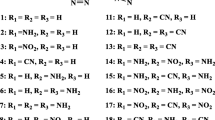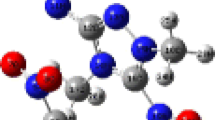Abstract
The salt with catenated N11 cation (N11), which has the longest nitrogen chain, was synthesized. N11 is a low-sensitivity cation with comparatively poor detonation performance because of its low density. To create energetic salts, we have designed 40 anions and paired them with N11. We computed the densities, HOFs, and detonation performance of these salts using density functional theory (DFT) and volume-based thermodynamics (VBT). We discovered that all of these salts have excellent detonation qualities and high densities. Specifically, salts A1 (ρ = 1.851 g cm−3, D = 8.76 km s−1 and P = 34.62 GPa) and salt B1 (ρ = 1.850 g cm−3, D = 8.78 km s−1 and P = 34.75 GPa) exhibit good detonation characteristics. Furthermore, we computed the deprotonation energy of both these anions and twelve other anions that have been synthesized experimentally. It was discovered that the deprotonation energies of every anion we created were less than the highest value of twelve anions that were synthesized experimentally. It provides a theoretical framework for the synthesis of energetic salts by demonstrating that every anion we designed is a feasible one.






Similar content being viewed by others
Availability of data and material
All the data and electronic materials are available for the Gaussian program.
Code availability
Chemdraw, Gaussian 09w, Gaussview.
References
Duan H, Yang J, Huang H, Li G (2021) Progress in the synthesis of energetic salts based on pyrazole. Chinense J Org Chem 41:1466
Yang H, Su K, Liu C, Ren X (2019) Energetic N-nitrooxyethylimidazolium salts: synthesis, structures and properties. Chem Select 4:10731–10736
Jadhav PM, Radhakrishnan S, Ghule VD, Pandey RK (2015) Energetic salts from nitroformate ion. J Mol Model 21:134
Liu L, Sun P, Zhang Y, Du F, Pang A (2020) Energetic double salts based on 4,4′,5,5′-tetranitro-2,2′-biimidazolate. J Mol Struct 1208:127861
Talawar MB, Sivabalan R, Anniyappan M (2007) Emerging trends in advanced high energy materials. Combust Explo Shock 43:62–72
Qu Y, Babailov SP (2018) Azo-linked high-nitrogen energetic materials. Journal of Materials Chemistry A 6:1915–1940
Wang X, Hao G, Xiao L, Hu Y, Zhang G, Wang S, Yang J, Jiang W (2023) Review on the thermal decomposition of dihydroxylammonium 5,5′- bistetrazole-1,1′-diolate (TKX-50). Thermochim Acta 719:179393
Tang Y, Yang H, Wu B, Ju X, Lu C, Cheng G (2013) Synthesis and characterization of a stable, catenated N11 energetic salt. Angew Chem Int Ed Engl 52:4875–4877
Luo Y, Zheng W, Wang X, Shen F (2022) Nitrification progress of nitrogen-rich heterocyclic energetic compounds: a review. Molecules 27:1465
Karaghiosoff K, Klaptke TM, Mayer P, Sabaté CM, Penger A, Welch JM (2008) Salts of methylated 5-aminotetrazoles with energetic anions. Inorg Chem 47:1007–1019
Wang R, Guo Y, Zeng Z, Shreeve JM (2009) Nitrogen-rich nitroguanidyl-functionalized tetrazolate energetic salts. Chem Commun (Camb) 19:2697–2699
Klapötke TM, Miró Sabaté C, Rasp M (2009) Synthesis and properties of 5-nitrotetrazole derivatives as new energetic materials. J Mater Chem 19:2240–2252
Pan Y, Zhu W (2018) Designing and looking for novel cage compounds based on bicyclo-HMX as high energy density compounds. RSC Adv 8:44–52
Miao X, Yang X, Li Y, Pang S (2023) Thermal stability of azole-rich energetic compounds: their structure, density, enthalpy of formation and energetic properties. Phys Chem Chem Phys 25:18523–18544
Hu L, He C, Zhao G, Imler GH, Parrish DA, JnM S (2020) Selecting suitable substituents for energetic materials based on a fused triazolo-[1,2,4,5]tetrazine ring. ACS Appl Energy Mater 3:5510–5516
Hu L, Staples RJ, Shreeve JM (2021) Energetic compounds based on a new fused triazolo[4,5-d]pyridazine ring: nitroimino lights up energetic performance. Chem Eng J 420:129839
Becke AD (1993) Density-functional thermochemistry. III. The role of exact exchange, J Chem Phys 98:5648–5652
Jenkins HDB, Glasser L (2006) Volume-based thermodynamics: estimations for 2:2 salts. Inorg Chem 45:1754
Frisch MJ, Trucks GW, Schlegel HB, Scuseria GE, Robb MA, Cheeseman JR, Scalmani G, Barone V, Mennucci B, Petersson GA (2009) Gaussian 09, Revision A.02, Wallingford, CT: Gaussian. Inc
Rice BM, Hare JJ, Byrd EFC (2007) Accurate predictions of crystal densities using quantum mechanical molecular volumes. J Phys Chem A 111:10874–10879
Pan J-F, Lee Y-W (2004) Crystal density prediction for cyclic and cage compounds. Phys Chem Chem Phys 6:471–473
Politzer P, Martinez J, Murray JS, Concha MC (2010) An electrostatic correction for improved crystal density predictions of energetic ionic compounds. Mol Phys 108:1391–1396
Jenkins H, Tudela D, Glasser L (2002) Lattice potential energy estimation for complex ionic salts from density measurements. Inorg Chem 41:2364–2367
Rayne S, Forest K (2010) Estimated gas-phase standard state enthalpies of formation for organic compounds using the Gaussian-4 (G4) and W1BD theoretical methods. J Chem Eng Data 55:5359–5364
Kamlet MJ, Jacobs SJ (1968) Chemistry of detonations. I. A simple method for calculating detonation properties of C-H–N–O explosives. J Chem Phys 48:23–35
Joseph A, Thomas VI, Żyła G, Padmanabhan AS, Mathew S (2017) Theoretical probing of weak anion–cation interactions in certain pyridinium-based ionic liquid ion pairs and the application of molecular electrostatic potential in their ionic crystal density determination: a comparative study using density functional approach. J Phys Chem A 122:328–340
Li XH, Zhang C, Ju XH (2019) Theoretical screening of bistriazole-derived energetic salts with high energetic properties and low sensitivity. RSC Adv 9:26442–26449
Li X, Tang Z, Zhang X, Yang X (2009) The heats of formation in a series of nitroester energetic compounds: a theoretical study. J Hazard Mater 165:372–378
Acknowledgements
The authors are thankful to the learned referees for their useful and critical comments, which helped improve the quality of the manuscript.
Author information
Authors and Affiliations
Contributions
The manuscript was written through contributions of all the authors.
Corresponding author
Ethics declarations
Conflict of interest
The authors declare no competing interests.
Additional information
Publisher's Note
Springer Nature remains neutral with regard to jurisdictional claims in published maps and institutional affiliations.
Supplementary Information
Below is the link to the electronic supplementary material.
Rights and permissions
Springer Nature or its licensor (e.g. a society or other partner) holds exclusive rights to this article under a publishing agreement with the author(s) or other rightsholder(s); author self-archiving of the accepted manuscript version of this article is solely governed by the terms of such publishing agreement and applicable law.
About this article
Cite this article
Pu, WW., Ammasi, A. & Ju, XH. Theoretical study on the structure and properties of energetic salts with catenated N11 cation. Struct Chem (2024). https://doi.org/10.1007/s11224-024-02319-z
Received:
Accepted:
Published:
DOI: https://doi.org/10.1007/s11224-024-02319-z




